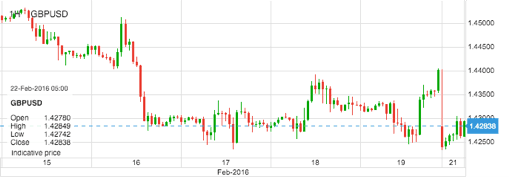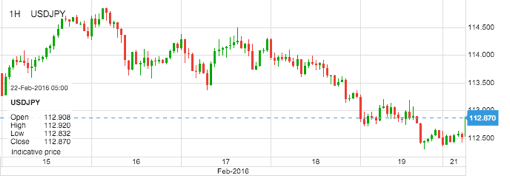Weekly Market Update 22.02.2016
GBPUSD: GBPUSD spent the past week mostly in bearish trend, as it has fallen once again to hit a major support area around the 1.4250 level. In the process, this trend has erased much of the gains made during the upside pullback of late January and early February, and could be the precursor to a longstanding bearish trend. Despite diminished expectations of another Federal Reserve rate hike having pressured the US dollar from the beginning of February, the greenback has rebounded in the past week. This has been very evident in GBPUSD perhaps due to shifting Fed expectations and the persistently weakened state of the British pound. This weakness stems partly from an increasingly dovish Bank of England that was previously expected to begin its own monetary tightening cycle at some point following the initiation of the Fed’s rate hike in December. These expectations have since diminished dramatically, and even reversed to accommodate the potential for a rate cut, given recent concerns over weak economic growth, financial market instability, and low inflation. As long as the Bank of England maintains a monetary policy stance that is consistently seen as even more dovish than the Fed’s, the underlying bearish trend for GBPUSD should continue.

USDJPY: USDJPY spent the early part of last week rallying with global equity markets, but then falling back towards the end of the week as crude oil prices struggled to maintain recent gains and stock markets felt renewed pressure after previously staging a sharp recovery. Stocks fell as crude oil suffered a blow from US Energy Information Administration data reporting that crude inventory rose by 2.1 million barrels in the previous week. While less of a build than expected, this data refuted an earlier report of a sizable draw in inventories. Crude oil prices fell on this news despite continuing hopes for a deal among major oil-producing nations to limit the production of crude. With stock market fluctuations having recently followed crude oil prices closely and the Japanese yen continuing to benefit from its safe haven status when equity markets fall, USDJPY retreated further from this past week’s 114.858 high to drop below the key 114.00 level once again and then hit a low just above 112.00. Though equities have recovered most of the losses from earlier in the month, any major return of market volatility may likely boost the yen even further, which could send USDJPY to new lows. This decline could be even further if the US Federal Reserve continues to be seen as increasingly dovish and unlikely to raise interest rates again this year. In this event, sustained pressure under the noted 114.00 level could begin to target further downside objectives at the key 110.00 and 108.00 support levels.

UPCOMING KEY MARKET EVENTS
|
Date/Time* |
Currency |
Event |
Previous |
| 25 Feb/0855 |
EUR |
Unemployment Rate s.a. (Feb) |
6.2% |
|
25 Feb/1000 |
EUR |
Consumer Price Index (YoY) (Jan) |
0.4% |
|
25 Feb/1330 |
USD |
Durable Goods Orders (Jan) |
-5.1% |
|
26 Feb/1330 |
USD |
Gross Domestic Product Annualized (Q4) |
0.7% |
Time : GMT (Source: Fab Trader Platform)
Fixed Deposit Rates (USD)
| Tier | 30 Days | 90 Days | 180 Days | 360 Days |
|---|---|---|---|---|
| 50k-99k | 0.40 | 0.75 | 1.00 | 1.25 |
| 100k-499k | 1.50 | 1.75 | 2.00 | 2.50 |
| 500k-999k | 2.00 | 2.25 | 2.50 | 2.75 |
| 1 Million and above | 2.00 | 2.75 | 3.00 | 4.00 |
(Source: Fab Treasury)
Fixed Deposit Rates (EUR & GBP)
| Currency | 30 Days | 90 Days | 180 Days | 360 Days |
|---|---|---|---|---|
| EUR | 0.12 | 0.20 | 0.25 | 0.30 |
| GBP | 0.70 | 0.81 | 0.90 | 1.21 |
(Source: Fab Treasury)
Market Rates (from 5th - 11th October)
| Currency | Open | Close | High | Low |
|---|---|---|---|---|
| USDJPY | 112.997 | 114.858 | 112.293 | 112.490 |
| GBPUSD | 1.43725 | 1.45334 | 1.42337 | 1.44009 |
| EURUSD | 1.12314 | 1.12490 | 1.10650 | 1.11261 |
| AUDUSD | 0.71007 | 0.71853 | 0.70663 | 0.71294 |
| USDZAR | 15.87111 | 15.88788 | 15.20978 | 15.3098 |
| USDGHS | 3.96447 | 3.98234 | 3.95741 | 3.98234 |
| USDNGN | 199.09111 | 199.68375 | 197.92449 | 199.66187 |
| USDKES | 102.11009 | 102.28457 | 101.52537 | 102.28457 |
(Source: Fab Trader Platform & exchange-rates.org)
Metals and Stocks (from 5th - 11th October)
| Metal | Open | Close | High | Low |
|---|---|---|---|---|
| Silver | 15.6578 | 15.7075 | 15.1135 | 15.3215 |
| Gold | 1,234.93 | 1,239.85 | 1,190.82 | 1,226.09 |
| Stocks | ||||
| US 500 | 1,868.95 | 1,936.42 | 1,868.95 | 1,916.92 |
| HK 50 | 18,612.0 | 19,443.0 | 18,612.0 | 19,298.0 |
| UK 100 | 5,740.80 | 6,064.50 | 5,740.30 | 5,944.76 |
| Germany 30 | 9,116.10 | 9,546.25 | 9,069.20 | 9,374.35 |
(Source: Fab Trader Platform)
Asia shares edge ahead with oil, pound slips
Asian share markets edged cautiously higher on Monday as investors awaited a rush of February industry surveys to take the pulse of the global economy, while sterling suffered on concerns the UK might yet vote to leave the European Union. A busy week for data culminates with a Group of 20 meeting that offers leaders a chance to soothe market concerns with talk of coordination, even if it produces nothing concrete.MSCI's broadest index of Asia-Pacific shares outside Japan .MIAPJ0000PUS edged up 0.7 percent, having rebounded more than 4 percent last week. The calmer mood was aided by oil as Brent crude LCOc1 added 31 cents to $33.32 and U.S. crude CLc1 rose 26 cents to $29.90. Japan's Nikkei .N225 recouped early losses to rise 0.7 percent, buoyed by a retreat in the yen even as an activity survey showed a drop in new export orders took a heavy toll on manufacturing. The Markit/Nikkei Flash Japan PMI fell to 50.2 in February, from 52.3 in January, a potentially bleak omen for the rest of the region. China's major stock indexes firmed as investors welcomed news over the weekend that the head securities regulator was being replaced."While we cannot definitively say the cycle/2016 lows are in place yet, the technical evidence continues to suggest a more durable bottom may be forming." (Source: reuters.com)
Oil prices rise on lower U.S. rig count, but glut weighs
"The U.S. oil rig count continued to decline..., with a total of 26 rigs idled," Goldman Sachs said. "The current rig count implies... annual average U.S. production would decrease by 445,000 barrels per day yoy (year-on-year) on average in 2016," it added. "We expect drops in U.S. production to be the source of bullishness," Singapore-based brokerage Phillip Futures said.
Despite Monday's gains, analysts said that market conditions remained weak, especially as demand is slowing. "The sharp deceleration in demand growth in recent months (especially gasoline) is a key feature of our more bearish view and expectations for a longer rebalancing period," Morgan Stanley said. China demand looks particularly challenged with several negative trends of late," it added.
In the United States, record crude stocks of 504.1 million barrels were also weighing on markets, countering a proposed production freeze at January levels by Russia and the Organization of the Petroleum Exporting Countries (OPEC). "Locking in countries' production near historic production highs does not change an oversupplied market," said Amos J. Hochstein, the U.S. State Department's special envoy for international energy affairs. (Source: reuters.com)



